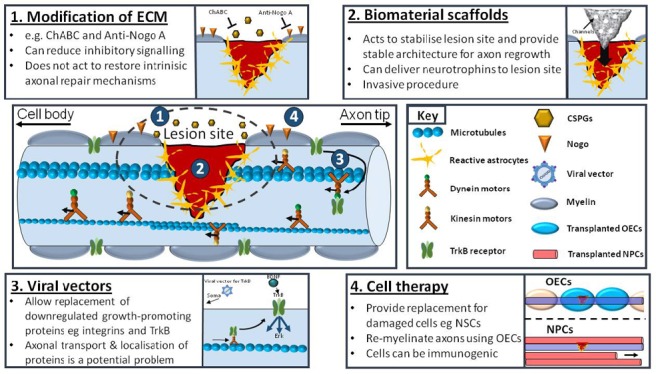Figure 1.

Current approaches for promoting axonal repair following central nervous system (CNS) injury.
Schematic diagram highlighting an overview of axonal injury and degradation at the lesion site along with current approaches to enhance repair. After CNS injury, an inhibitory lesion site is created surrounded by reactive astrocytes and a number of growth-inhibiting proteins including CSPGs and Nogo. Transport within axons is mediated by both kinesin and dynein motors and allows cargo-carrying vesicles to travel in both anterograde and retrograde directions. However, within the mature CNS many growth-promoting proteins, such as TrkB, are trafficked back to the cell body in the retrograde direction resulting in a reduced ability of axons to regenerate after injury. (1) Modification of the ECM using ChABC enzyme to degrade CSPGs or anti-Nogo A antibodies to inhibit Nogo activity can reduce the action and signalling of inhibitory components in the injury site to promote axonal regeneration after injury. (2) Biomaterials can be used to stabilize the lesion site as well as provide guidance channels for axon regrowth. Modified scaffolds have been used to deliver multiple neurotrophic factors to lesion site to aid axon repair. (3) Alternatively, delivery of viral vectors that are tissue or cell-specific can carry DNA encoding for growth-promoting proteins e.g., TrkB to the lesion site. Using gene therapy to reinstate proteins involved in axon growth and guidance can prompt growth-promoting signalling pathways. (4) Cell therapy involves replacing lost or damaged cells at the lesion site. These can include OECs to promote remyelination of injured axons or transplantation of NSCs to replace injured neurons/axons. ChABC: Chondroitinase ABC; CSPGs: chondroitin sulphate proteoglycans; ECM: extracellular matrix; NPC: neural progenitor cell; NSC: neural stem cell; OECs: olfactory ensheathing cells; TrkB: tropomyosin receptor kinase B.
